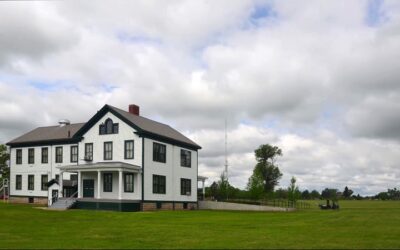On May 26, 1885, four families of Bohemian emigrants traveling in three covered wagons drawn by ox teams, camped in Richmond Canyon between Bartley and Cambridge. About 9 p.m. a wall of water raced down the canyon and swept the entire camp away. Of the seventeen members of the party, three women and six children were drowned. To commemorate this incident in the early history of Red Willow County, a monument was erected close to the site where these emigrants camped for the night and exercises were held there June 6, 1924, participated in by 2,500 persons, who gathered from all parts of southwestern Nebraska.
The exercises consisted of music by the Cambridge band and addresses by C. E. Eldred of McCook, B. F. Butler of Cambridge, A. M. Keyes of Holbrook, and others. The ceremony was especially impressive because of the presence of two of the three living survivors, John Osmera and Mary Osmera, his sister, of Brainard, Nebraska. The only other living survivor of the disaster (in 1924) was Mary Vlostin of St. Paul. The gathering included a large number of persons who were residents of the county thirty-nine years before, when the water overwhelmed the campers, and several were present who had searched for and found the bodies of the dead.
Mr. Osmera’s account of the disaster was that he and his sister who had survived were sleeping in one of the wagons. About 9 p.m. the water from a cloudburst to the north came down the canyon. His father was aroused and rescued himself and his sister, then went to the assistance of his mother and another brother and sister who were in another wagon, but it was too late. They had been swept away. The party was on its way to homestead lands in Hayes County.



